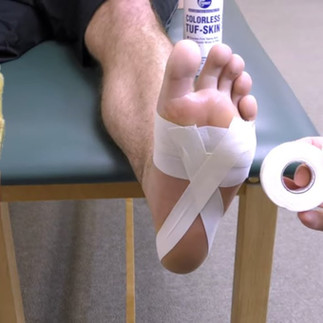How Sports Taping Can Support Your Performance
- Nathalie Agius
- Apr 29
- 2 min read
Updated: Nov 19
Whether you're recovering from an injury, managing muscle fatigue, or just want extra support during training or competition, sports taping can be a simple yet highly effective tool to help you perform at your best.
Used by athletes at all levels, taping can improve movement, reduce discomfort, and give your body the support it needs when it matters most.
What Is Sports Taping?
Sports taping involves applying adhesive tape to specific areas of the body to:
Support joints and muscles
Improve body awareness (proprioception)
Reduce strain on injured or overused areas
Encourage better posture and alignment during movement
Aid recovery without limiting mobility
The tape is applied based on your movement patterns, goals, or injury history. It can be used before a match, during training, or as part of your rehab plan.
How Does It Help Athletes?
Taping doesn’t just “hold things in place” — it plays a more active role in performance and recovery. Here’s how it benefits athletes:
✅ Reduces muscle fatigue during intense or repetitive activity
✅ Supports unstable joints without restricting natural movement
✅ Relieves tension and pressure in overused or sore muscles
✅ Enhances movement awareness, helping correct poor patterns
✅ Speeds up recovery by promoting circulation and reducing swelling
✅ Builds confidence during return-to-play after injury
Whether you're managing a niggle, pushing through a tough training cycle, or looking to prevent re-injury, sports taping can give your body the support it needs.
Types of Sports Taping
Different taping methods are used based on your needs and sport:
🔹 Kinesiology Tape: Elastic and flexible, this tape is designed to move with your body. It helps relieve pain, support muscle function, and reduce inflammation while allowing full range of motion. Ideal for training, recovery, and general muscle support.
🔹 Rigid Sports Tape: Non-stretch tape that provides firm support for joints, often used to stabilize ankles, knees, or toes during high-impact activities. Common in contact sports or post-injury.
Each tape has its purpose — and knowing when and how to use it is key to getting the best results.
Is Taping Right for You?
Taping can be helpful if you:
Feel unstable or vulnerable in a joint during activity
Are recovering from a strain, sprain, or overuse injury
Want support during training or competition
Need help managing swelling or muscular fatigue
Are returning to sport after injury and want added confidence
Book a Taping Session or Add It to Your Rehab Plan
Taping is often most effective when used alongside other treatments like manual therapy, dry needling, and exercise rehab. If you’re interested in using sports taping to support your performance or recovery, I can assess your needs and apply the right taping technique to help you move and perform better.
For more information, or to book an appointment, call or WhatsApp on +35699212441.















Comments